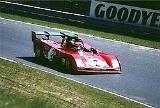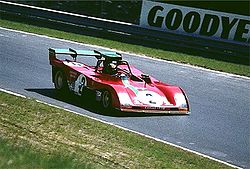
Ferrari 312PB
Encyclopedia
The Ferrari 312PB was a Group 6 Prototype-Sports Car
introduced in 1971 by Italian carmaker Ferrari
. It was officially designated the 312P, but often known as the 312PB to avoid confusion with a previous car of the same name. It was part of the Ferrari P
series of Prototype-Sports Cars but was redesignated as a Group 5 Sports Car
for 1972.
and Ferrari 512
) was closed, and the minimum weight of the 3L prototypes was raised to 650 kg (1,433 lb).
Porsche considered this too heavy as their Porsche 908
/03 were 100 kg (220 lb) lighter, and this advantage would have been lost. On the other hand, their aircooled two-valve engine was low on power with 370 hp, and the development of a new engine would have been necessary. Thus, Porsche did not enter world championship sports car races after 1971 and sold the 908s to customers who would have to add weight to them. Matra
and Alfa Romeo
were willing and able to compete, but only in selected seasons or events. Also, Ford's successful Formula 1 Cosworth
-V8 engine was available for independent chassis builders, but vibrations made it unreliable for endurance racing.
After having been beaten by the Porsche 917 in 1970, Ferrari abandoned further development of the Ferrari 512M, leaving the 512 to customer teams like Penske Racing
, which had some success with their improved 512M in 1971, though. Penske, probably not very happy about the lack of support from the factory, joined Porsche for their Can-Am effort with the turbocharged Porsche 917
/10.
 Instead, in 1971, Ferrari focused on a new 3.0L prototype based on the 180° flat-12 boxer from the 312B F1 car. Officially this design was known as 312P, the motorsports press appending the B to avoid confusion with the earlier 312P V12 cars. This design was similar to the traditional Porsche engine layout with its low center of gravity, but Ferrari used water-cooling and 4-valve heads. The car was promising, but did not win, while the similar Alfa Romeo 33 scored two wins against Porsche's dominance.
Instead, in 1971, Ferrari focused on a new 3.0L prototype based on the 180° flat-12 boxer from the 312B F1 car. Officially this design was known as 312P, the motorsports press appending the B to avoid confusion with the earlier 312P V12 cars. This design was similar to the traditional Porsche engine layout with its low center of gravity, but Ferrari used water-cooling and 4-valve heads. The car was promising, but did not win, while the similar Alfa Romeo 33 scored two wins against Porsche's dominance.
races in which it was entered. Ferrari skipped the 1972 24 Hours of Le Mans
, though, as the F1-based engine would not last 24 hours and surely spoil their otherwise perfect record.
In 1973, Matra which had previously focused on Le Mans also challenged for the championship while Alfa was absent. As Matra won several races, Ferrari needed to enter in the 1973 24 Hours of Le Mans
, with an improved yet still doubtful engine. One car was used as a "hare" which supposed to lure the Matras into driving faster laps than they intended, to test their reliability. Ironically it was only the "hare" Ferrari which survived the 24 hours, finishing a respectable second behind a Matra
. The championship saw the same order, with only two Italian wins compared to five French. In addition, despite the absence of the Matras, the 312PB could not defend the 1972 win of the Targa Florio
as the prototypes of Ferrari and Alfas failed and a Porsche 911
collected a surprise win.
At the end of the 1973 season, Ferrari abandoned sports car racing to focus on F1 again, as the F1 team had even skipped GP races in 1973 due to lack of competitiveness.
Group 6 (racing)
Group 6 was the official designation applied by the FIA to two motor racing classifications, the Prototype-Sports Car category from 1966 to 1971 and the Two-Seater Racing Cars class from 1976 to 1982.-Group 6 Prototype-Sports Cars :...
introduced in 1971 by Italian carmaker Ferrari
Ferrari
Ferrari S.p.A. is an Italian sports car manufacturer based in Maranello, Italy. Founded by Enzo Ferrari in 1929, as Scuderia Ferrari, the company sponsored drivers and manufactured race cars before moving into production of street-legal vehicles as Ferrari S.p.A. in 1947...
. It was officially designated the 312P, but often known as the 312PB to avoid confusion with a previous car of the same name. It was part of the Ferrari P
Ferrari P
The Ferrari P series were prototype sports cars in the 1960s and early 1970s.Although Enzo Ferrari resisted the move even with Cooper dominating F1, Ferrari began producing mid-engined racing cars in 1960 with the Ferrari Dino-V6-engine Formula Two 156, which would be turned into the Formula...
series of Prototype-Sports Cars but was redesignated as a Group 5 Sports Car
Group 5 (racing)
Group 5 was an FIA motor racing classification which was applied to four distinct categories during the years 1966 to 1982. Initially Group 5 regulations defined a Special Touring Car category and from 1970 to 1971 the classification was applied to limited production Sports Cars restricted to 5...
for 1972.
Development
In 1970, a change in the regulations for sportscar racing for 1972 was announced. The loophole for the big 5L sports cars (such as the Porsche 917Porsche 917
The Porsche 917 is a racecar that gave Porsche its first overall wins at the 24 Hours of Le Mans in 1970 and 1971. Powered by the Type 912 flat-12 engine of 4.5, 4.9, or 5 litres, the 917/30 variant was capable of a 0- time of 2.3 seconds, 0– in 5.3 seconds, and a top speed of over .There are 6...
and Ferrari 512
Ferrari 512
Ferrari 512 S was the designation of 25 five litre sports cars built until January 1970, related to the Ferrari P sports prototypes. The V12-powered cars were entered in the 1970 International Championship for Makes by the factory Scuderia Ferrari and private teams...
) was closed, and the minimum weight of the 3L prototypes was raised to 650 kg (1,433 lb).
Porsche considered this too heavy as their Porsche 908
Porsche 908
The Porsche 908 was a racing car from Porsche, introduced in 1968 to continue the Porsche 906/Porsche 910/Porsche 907 series of models designed under Ferdinand Piech....
/03 were 100 kg (220 lb) lighter, and this advantage would have been lost. On the other hand, their aircooled two-valve engine was low on power with 370 hp, and the development of a new engine would have been necessary. Thus, Porsche did not enter world championship sports car races after 1971 and sold the 908s to customers who would have to add weight to them. Matra
Matra
Mécanique Aviation Traction or Matra was a French company covering a wide range of activities mainly related to automobile, bicycles, aeronautics and weaponry. In 1994, it became a subsidiary of the Lagardère Group and now operates under that name.Matra was owned by the Floirat family...
and Alfa Romeo
Alfa Romeo in motorsport
During its history, Alfa Romeo has competed successfully in many different categories of motorsport, including Grand Prix motor racing, Formula One, sportscar racing, touring car racing and rallies. They have competed both as a constructor and an engine supplier, via works entries and private...
were willing and able to compete, but only in selected seasons or events. Also, Ford's successful Formula 1 Cosworth
Cosworth
Cosworth is a high performance engineering company founded in London in 1958, specialising in engines and electronics for automobile racing , mainstream automotive and defence industries...
-V8 engine was available for independent chassis builders, but vibrations made it unreliable for endurance racing.
After having been beaten by the Porsche 917 in 1970, Ferrari abandoned further development of the Ferrari 512M, leaving the 512 to customer teams like Penske Racing
Penske Racing
Penske Racing is a racing team that competes in the IndyCar Series and NASCAR. They also previously competed in road racing, and Formula One. Penske Racing is a division of Penske Corporation, and is owned and chaired by Roger Penske...
, which had some success with their improved 512M in 1971, though. Penske, probably not very happy about the lack of support from the factory, joined Porsche for their Can-Am effort with the turbocharged Porsche 917
Porsche 917
The Porsche 917 is a racecar that gave Porsche its first overall wins at the 24 Hours of Le Mans in 1970 and 1971. Powered by the Type 912 flat-12 engine of 4.5, 4.9, or 5 litres, the 917/30 variant was capable of a 0- time of 2.3 seconds, 0– in 5.3 seconds, and a top speed of over .There are 6...
/10.

Racing history
In 1972, with only Alfa answering the challenge, the 312PB was very successful and won all World Sportscar ChampionshipWorld Sportscar Championship
The World Sportscar Championship was the world series run for sports car racing by the FIA from 1953 to 1992.The championship evolved from a small collection of the most important sportscar, endurance and road racing events in Europe and North America with dozens of gentleman drivers at the grid,...
races in which it was entered. Ferrari skipped the 1972 24 Hours of Le Mans
1972 24 Hours of Le Mans
The 1972 24 Hours of Le Mans was the 40th Grand Prix of Endurance, and took place on June 10 and 11 1972. It was the ninth round of the World Sportscar Championship.-Pre-race:...
, though, as the F1-based engine would not last 24 hours and surely spoil their otherwise perfect record.
In 1973, Matra which had previously focused on Le Mans also challenged for the championship while Alfa was absent. As Matra won several races, Ferrari needed to enter in the 1973 24 Hours of Le Mans
1973 24 Hours of Le Mans
The 1973 24 Hours of Le Mans was the 41st Grand Prix of Endurance, and took place on June 9 and 10 1973. It was the eighth round of the World Championship of Makes.-Pre-race:...
, with an improved yet still doubtful engine. One car was used as a "hare" which supposed to lure the Matras into driving faster laps than they intended, to test their reliability. Ironically it was only the "hare" Ferrari which survived the 24 hours, finishing a respectable second behind a Matra
Matra
Mécanique Aviation Traction or Matra was a French company covering a wide range of activities mainly related to automobile, bicycles, aeronautics and weaponry. In 1994, it became a subsidiary of the Lagardère Group and now operates under that name.Matra was owned by the Floirat family...
. The championship saw the same order, with only two Italian wins compared to five French. In addition, despite the absence of the Matras, the 312PB could not defend the 1972 win of the Targa Florio
Targa Florio
The Targa Florio was an open road endurance automobile race held in the mountains of Sicily near Palermo. Founded in 1906, it was the oldest sports car racing event, part of the World Sportscar Championship between 1955 and 1973...
as the prototypes of Ferrari and Alfas failed and a Porsche 911
Porsche 911
The Porsche 911 is a luxury 2-door sports coupe made by Porsche AG of Stuttgart, Germany. It has a distinctive design, rear-engined and with independent rear suspension, an evolution of the swing axle on the Porsche 356. The engine was also air-cooled until the introduction of the Type 996 in 1998...
collected a surprise win.
At the end of the 1973 season, Ferrari abandoned sports car racing to focus on F1 again, as the F1 team had even skipped GP races in 1973 due to lack of competitiveness.

